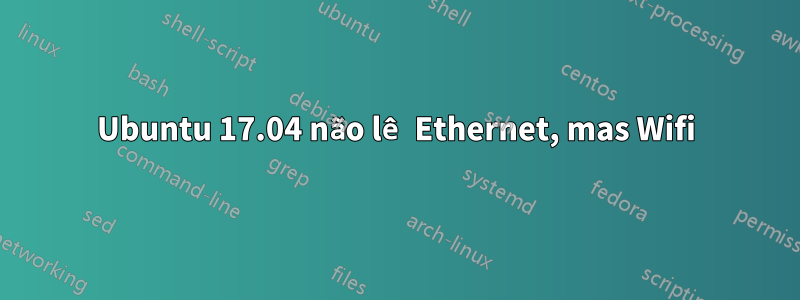
Asus Q550LF 8 Gb i7 1 TB
Ao atualizar de 16.04 para 16.10, o Ubuntu renomeou a placa de rede. WiFi funcionou, mas não Ethernet. Procedi à atualização para 17.04 e o problema foi transferido. A Ethernet ainda funciona bem com o Win 8.1. Como posso consertar isso?
$ ifconfig -a
enp2s0: flags=4163<UP,BROADCAST,RUNNING,MULTICAST> mtu 1500
inet 192.168.0.10 netmask 255.255.255.0 broadcast 192.168.0.255
inet6 fe80::dc01:cf88:1f7c:1 prefixlen 64 scopeid 0x20<link>
inet6 2605:e000:2342:e700::4 prefixlen 128 scopeid 0x0<global>
inet6 2605:e000:2342:e700:f7f:f32c:93b7:3d16 prefixlen 64 scopeid 0x0<global>
ether 10:c3:7b:1e:ea:cd txqueuelen 1000 (Ethernet)
RX packets 7963 bytes 2709308 (2.7 MB)
RX errors 0 dropped 785 overruns 0 frame 0
TX packets 2260 bytes 348549 (348.5 KB)
TX errors 0 dropped 0 overruns 0 carrier 0 collisions 0
lo: flags=73<UP,LOOPBACK,RUNNING> mtu 65536
inet 127.0.0.1 netmask 255.0.0.0
inet6 ::1 prefixlen 128 scopeid 0x10<host>
loop txqueuelen 1000 (Local Loopback)
RX packets 4763 bytes 311223 (311.2 KB)
RX errors 0 dropped 0 overruns 0 frame 0
TX packets 4763 bytes 311223 (311.2 KB)
TX errors 0 dropped 0 overruns 0 carrier 0 collisions 0
wlp3s0: flags=4163<UP,BROADCAST,RUNNING,MULTICAST> mtu 1500
inet6 2605:e000:2342:e700:5283:43a0:e0ed:ded prefixlen 64 scopeid 0x0<global>
inet6 2605:e000:2342:e700:d9aa:3889:eb23:538f prefixlen 64 scopeid 0x0<global>
inet6 2605:e000:2342:e700::2 prefixlen 128 scopeid 0x0<global>
inet6 fe80::92f1:5157:464b:a1a9 prefixlen 64 scopeid 0x20<link>
ether 80:86:f2:08:b2:8b txqueuelen 1000 (Ethernet)
RX packets 3957 bytes 444699 (444.6 KB)
RX errors 0 dropped 0 overruns 0 frame 0
TX packets 713 bytes 218381 (218.3 KB)
TX errors 0 dropped 0 overruns 0 carrier 0 collisions 0
E
$ sudo lshw -C network
*-network
description: Ethernet interface
product: RTL8111/8168/8411 PCI Express Gigabit Ethernet Controller
vendor: Realtek Semiconductor Co., Ltd.
physical id: 0
bus info: pci@0000:02:00.0
logical name: enp2s0
version: 0c
serial: 10:c3:7b:1e:ea:cd
size: 1Gbit/s
capacity: 1Gbit/s
width: 64 bits
clock: 33MHz
capabilities: pm msi pciexpress msix vpd bus_master cap_list ethernet physical tp mii 10bt 10bt-fd 100bt 100bt-fd 1000bt 1000bt-fd autonegotiation
configuration: autonegotiation=on broadcast=yes driver=r8169 driverversion=2.3LK-NAPI duplex=full firmware=rtl8168g-2_0.0.1 02/06/13 ip=192.168.0.10 latency=0 link=yes multicast=yes port=MII speed=1Gbit/s
resources: irq:42 ioport:e000(size=256) memory:f7900000-f7900fff memory:f2100000-f2103fff
*-network
description: Wireless interface
product: Wireless 7260
vendor: Intel Corporation
physical id: 0
bus info: pci@0000:03:00.0
logical name: wlp3s0
version: 6b
serial: 80:86:f2:08:b2:8b
width: 64 bits
clock: 33MHz
capabilities: pm msi pciexpress bus_master cap_list ethernet physical wireless
configuration: broadcast=yes driver=iwlwifi driverversion=4.10.0-20-generic firmware=17.459231.0 ip=192.168.0.39 latency=0 link=yes multicast=yes wireless=IEEE 802.11
resources: irq:46 memory:f7800000-f7801fff
Responder1
Você pode me fazer um favor e tirar todas essas informações extras, preciso de um ifconfig básico
não -a.
desative a conexão sem fio ao tentar usar a conexão com fio.
quais são suas configurações para conexão com fio estática ou dhcp e se dhcp tente estático com dns estático também 8.8.8.8 ou 8.8.4.4 é googles dns e veja se você consegue acesso à internet.
Se isso não funcionar, volte ao dhcp antes de tentar o resto.
pode tentar desligar o dispositivo e depois ligá-lo.
ifconfig eth0 desativado
ifconfig eth0 up
eth0 = seu dispositivo Ethernet, algumas vezes o nome da chamada é diferente, um ifconfig básico revelará o nome da chamada na extremidade esquerda do terminal.
tente também
reinicialização da rede do serviço sudo
você também pode usar traceroute para ver até onde a conexão chega para ver se está chegando ao lado externo
sudo apt-get install traceroute
EX: traceroute google.com
às vezes você pode desabilitar qualquer uma das redes através de sua BIOS. Eu me certificaria de que não estivesse desabilitado em algum lugar lá. se você nunca acessou a BIOS anteriormente, provavelmente não será esse o caso.
tentar
endereço ip flush eth0
Achei isso interessante, pois contém muitas informações sobre como descobrir mais informações sobre seu estado de rede.
https://help.ubuntu.com/lts/serverguide/network-configuration.html
Eu gosto dessa ideia, use este gerenciador de rede em vez do estoque, que pode não estar funcionando corretamente


